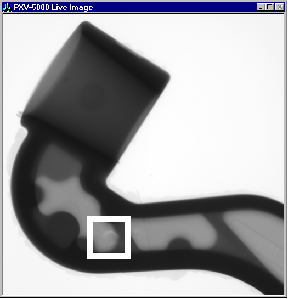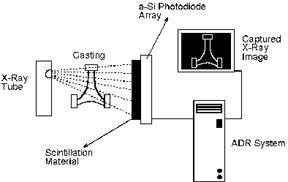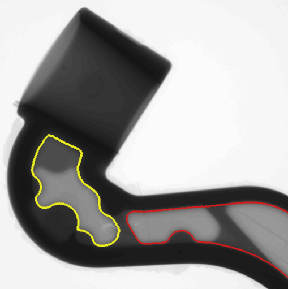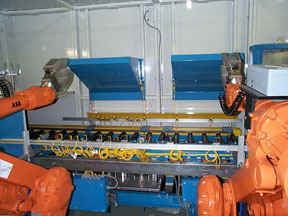Automatic X-ray Inspection of Structural Castings
For years the castings industry has used X-ray inspection to verify the structural integrity of its castings. The first manually operated off-line film-based inspection systems have been replaced with fully automatic real-time X-ray systems able to make pass/fail decisions without operator intervention. Today’s systems can be integrated directly into the manufacturing process and even help monitor it.
 A variety of defects are inherent in the casting process.
Depending on part design and processing techniques, castings may develop discontinuities
such as cracks or tearing, inclusions due to chemical reactions or foreign material in the
molten metal, porosity caused by shrinkage or gases, and more. (See figure 1.) Each of
these defects may act as a stress riser and make a fracture point. If pressure is applied
in this area, the casting could fracture.
A variety of defects are inherent in the casting process.
Depending on part design and processing techniques, castings may develop discontinuities
such as cracks or tearing, inclusions due to chemical reactions or foreign material in the
molten metal, porosity caused by shrinkage or gases, and more. (See figure 1.) Each of
these defects may act as a stress riser and make a fracture point. If pressure is applied
in this area, the casting could fracture.
Castings such as steering knuckles, control arms, transmission mounts, and cross members are critical structural components. The quality and dependability of these castings is crucial. Each must conform to rigid specifications set forth by automobile manufacturers. Conformance is verified by 100 percent X-ray inspection.
Because today’s castings manufacturers run 24 hours a day, 7 days a week, they require X-ray inspection systems that can run at production line speeds. In response to the challenge, YXLON International has developed the MU59 and MU69 Automatic X-ray Inspection Systems. (This paper will focus on the MU59.) When coupled with the PXV5000 Total System Control and Defect Recognition System, these systems can provide fully automatic X-ray inspection at production line speeds. The PXV5000 System offers a number of basic and add-on modules that allow each system to be customized to meet the manufacturer’s specific needs.
X-ray inspection usually occurs after the castings have been trimmed. Castings are transported to the X-ray system’s entry conveyor. They are identified by an optional automatic part identification system or by a manually entered part identification number. The casting enters the lead inspection room. When the casting is in position, a robot picks it up, moves it to the imaging station, and performs a series of preprogrammed movements as the imaging system collects data and displays images on the system monitor.
As the image is displayed, the image data is also sent to a computer for evaluation. A pass/fail decision is made by the system and the robot is signaled to handle the part as either accepted or rejected. Castings may be routed to the appropriate chute or conveyor. Good castings can also be marked in a pre-selected area of the casting. Accepted castings continue through the manufacturing process while rejected castings are eventually melted down and re-cast.
 The X-ray inspection system utilizes two 6-axes robots. (See
figure 2.) As one robot is moving the part through its imaging positions, a second robot
is unloading its part in the accept/reject chute and loading the next part to be
inspected. Depending on the manufacturer’s requirements, some systems may incorporate
a second imaging station. Both robots can then load, X-ray, and unload castings
concurrently.
The X-ray inspection system utilizes two 6-axes robots. (See
figure 2.) As one robot is moving the part through its imaging positions, a second robot
is unloading its part in the accept/reject chute and loading the next part to be
inspected. Depending on the manufacturer’s requirements, some systems may incorporate
a second imaging station. Both robots can then load, X-ray, and unload castings
concurrently.
The quality and reliability of an automatic X-ray inspection system is largely dependent on the quality of its imaging system. For years, X-ray inspection systems used image intensifier-based imaging systems. While these systems perform well, there are inherent shortcomings. Image intensifiers degrade or start to turn dark over time which affects image quality. They are 8-bit systems with only 256 gray levels which limits resolution. It is also difficult to see thick and thin sections of a casting without losing sight of the casting’s edge due to blooming.
In recent years, sensor panel imagers have been introduced which offer many advantages over image intensifiers. YXLON International now incorporates this digital X-ray imager into its X-ray inspection systems. The outcome is extended life of the imaging system due to reduced degradation. The 16-bit panel offers superior resolution with 65,536 possible gray levels. It also incorporates a windowing technique which enables it to display image data at multiple gray level settings for each imaging position. This allows details to be gathered from thick as well as thin sections of a casting without blooming effects.
 The sensor panel imager selected for the casting
inspection task incorporates an amorphous silicon (a-Si) photodiode array which is coupled
to a scintillation material which fluoresces when hit by X-rays. (See figure 3.) When the
X-rays strike the scintillator material, they are converted to visible light which is
detected by the a-Si photodiode array and transformed into electrical signals. The
electrical signals are extracted from the sensor and a digital image is produced. The
captured image can be displayed on a monitor for viewing or stored in a database for
future reference. The same high resolution digital information used to generate the
monitor image is also analyzed by the PXV5000 Defect Recognition System (ADR).
The sensor panel imager selected for the casting
inspection task incorporates an amorphous silicon (a-Si) photodiode array which is coupled
to a scintillation material which fluoresces when hit by X-rays. (See figure 3.) When the
X-rays strike the scintillator material, they are converted to visible light which is
detected by the a-Si photodiode array and transformed into electrical signals. The
electrical signals are extracted from the sensor and a digital image is produced. The
captured image can be displayed on a monitor for viewing or stored in a database for
future reference. The same high resolution digital information used to generate the
monitor image is also analyzed by the PXV5000 Defect Recognition System (ADR).
 The ADR system requires that a test routine be created for each
new casting to be inspected. All settings required for automatic operation of the system
must be detailed. Establishing a new routine or modifying an old one requires five menu
driven steps. During this process a part code and test program number are assigned, robot
positions are defined, parameters are defined for each test position and each test region,
and evaluation regions are outlined and detection sensitivity is adjusted. (See figure 4.)
Good castings are then run through the system to verify settings and perform a teaching
routine which allows the system to automatically fine tune its parameters for a good part.
The ADR system requires that a test routine be created for each
new casting to be inspected. All settings required for automatic operation of the system
must be detailed. Establishing a new routine or modifying an old one requires five menu
driven steps. During this process a part code and test program number are assigned, robot
positions are defined, parameters are defined for each test position and each test region,
and evaluation regions are outlined and detection sensitivity is adjusted. (See figure 4.)
Good castings are then run through the system to verify settings and perform a teaching
routine which allows the system to automatically fine tune its parameters for a good part.
The inspection time required for a casting is determined by the number of views required. The number of views required is determined by the part and its geometry. While many castings require six or fewer views, some castings (such as cross members) may require as many as 38. Image acquisition time is less than two seconds per view. Part handling times vary depending on the manipulation technique used. Multiple test programs can be stored in the system and recalled for future use.
Once the test parameters for a part are defined, the PXV5000 Total System Control and Defect Recognition System enables the inspection system to operate automatically--without operator intervention. Replacing a human operator with a computer is always a difficult transition; however, there are benefits to be realized. Improved inspection consistency can improve scrap rates by as much as 20-50 percent. By removing human variability and thus narrowing the inspection parameters, the number of defective castings passed as good, or conversely the number of good castings returned as defective, can be reduced. Reducing the number of or eliminating the need for operators in the X-ray inspection process can further contribute to cost savings.
Automatic X-ray inspection offers many advantages to today’s casting manufacturers. Among them are consistent inspection to insure customer requirements are met, increased inspection throughput and reduced inspection labor for reduced inspection expense, and statistical reporting to assist in process monitoring. X-ray inspection has long been an integral part of the casting manufacturing process. Automatic X-ray inspection is the next logical step.
Case Study
A major supplier of structural castings to the automotive industry produces 1.4 million steering knuckles per year. Each casting must be 100 percent X-ray inspected. This supplier has chosen YXLON International’s MU59 to help monitor the quality of this high volume job. In addition to the basic system control and image analysis modules, this system incorporates the part recognition, statistical data, part marking, and part sorting add-on modules.
The MU59 is integrated directly into the manufacturing process. A live image is displayed during the inspection process for use in troubleshooting process variations. Accept/reject statistics displayed by the system are also used to monitor the entire casting process. Variations in the percentages trigger investigations into changes in the manufacturing process.
 The casting is placed on a pallet and moved into the inspection
room via an entry conveyor. It is picked up by a robot which moves it to the imaging area
and begins a series of preprogrammed movements which enable data to be acquired for each
critical area. This digital data is used to generate a live image on the system monitor
and is sent to the PXV5000 defect recognition system for analysis. The PXV5000 signals
pass or fail to the robot which then deposits the casting into the appropriate accept or
reject chute. Accepted castings are also marked with an X.
The casting is placed on a pallet and moved into the inspection
room via an entry conveyor. It is picked up by a robot which moves it to the imaging area
and begins a series of preprogrammed movements which enable data to be acquired for each
critical area. This digital data is used to generate a live image on the system monitor
and is sent to the PXV5000 defect recognition system for analysis. The PXV5000 signals
pass or fail to the robot which then deposits the casting into the appropriate accept or
reject chute. Accepted castings are also marked with an X.
Images are generated at two different gray scale ranges for each of four imaging positions in order to inspect all critical areas of each casting. On average more than 250 castings per hour are inspected. Prior to the MU59, manual inspections were performed at rates of approximately 80 - 85 castings per hour. Past inspections were also performed using film-based systems. In addition to slow inspection times, film and chemical costs could exceed $1 per part.
Before the first MU59/PXV5000 system was approved for installation, it first had to pass a set of rigorous test requirements developed by our customer. Each additional system purchased must pass a similar test before it is shipped. These systems have increased overall inspection rates by approximately 250 percent and continue to prove themselves a reliable, integral part of the casting process.